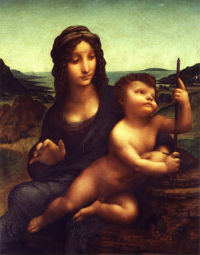
- Enlarge
- Zoom & explore
- © By kind permission of the Duke of Buccleuch & Queensberry, KT
Madonna of the Yarnwinder c1501-07
This is one of two paintings of the same subject associated with Leonardo. The attribution of this small panel continues to be the subject of debate, with most scholars denying an attribution to the master himself in favour of workshop assistants.
However, the results of recent scientific examination indicate that the overall design of the work is likely to be the work of Leonardo, as are some areas of the composition, such as the finely modelled head of the Christchild and the skilfully painted rocks in the foreground.
Infrared reflectography has revealed a range of pentimenti, or “small changes” in the underdrawing, which is characteristic of Leonardo and his compositional drawing practice. Minor adjustments have been made to the limbs of the Christchild and to the contours of the Virgin’s face and features. Originally the neckline of her dress was drawn marginally higher and her left foot included at the base of the panel.
The background of the painting is significantly different to the underdrawn design. To the left of the Virgin, a door or window was drawn together with a series of diagonal lines that appear to relate to a building and other forms drawn in perspective. Under the sky to the right of her head a series of curved lines perhaps relate to a mountainous landscape. The large scale of the Christchild is entirely characteristic of Leonardo as a means of emphasizing Christ’s importance as is the interest in transparent fabrics and the sfumato or “smoky” effect achieved in the fleshtones of the Virgin’s face.
While the distant seascape is rather untypical of the artist’s work, it may be seen in this context as a reference to the Virgin as “Stella Maris” or star of the sea - a metaphor from the Song of Songs in the Bible.
- Medium Oil on panel
- Size 48.3 x 36.9 cm
- Location Duke of Buccleuch & Queensberry, KT

